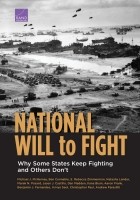| 来源类型 | Research Reports
|
| 规范类型 | 报告
|
| DOI | https://doi.org/10.7249/RR2477
|
| ISBN | 9781977400536
|
| 来源ID | RR-2477-A
|
| National Will to Fight: Why Some States Keep Fighting and Others Don't |
| Michael J. McNerney; Ben Connable; S. Rebecca Zimmerman; Natasha Lander; Marek N. Posard; Jasen J. Castillo; Dan Madden; Ilana Blum; Aaron Frank; Benjamin J. Fernandes; et al.
|
| 发表日期 | 2018
|
| 出版年 | 2018
|
| 页码 | 154
|
| 语种 | 英语
|
| 结论 |
National will to fight has been insufficiently analyzed, but RAND Arroyo Center's multi-method research has identified some key variables to help understand and influence it- Will to fight is poorly analyzed and the least understood aspect of war.
- A country with more factors in its favor (e.g., high stakes, strong cohesion, popular support) should have stronger will to fight and thus a higher chance of victory.
- Political context (i.e., government type and national identity) plays an underlying but important role in strengthening or weakening will to fight. The research supports the proposition that strong democracies and totalitarian states are better able to maintain will to fight (through very different means) compared with democracies in turmoil or states with a mix of democratic and autocratic traits.
- The influence of economic variables on will to fight depends on a government's alliances and its engagement with other countries. A country's economic dependency on and support from its allies often matter more than economic pressures from an adversary.
- The effective use of engagement and information (internally directed indoctrination and externally directed messaging) can greatly influence will to fight and thus should improve the chances of victory. These mechanisms are most effective before a conflict begins.
- When will to fight is evenly matched, superior military capabilities and infliction of greater casualties should lead to victory — or stalemate. In some scenarios, however, the infliction of casualties is actually more likely to strengthen an adversary's will to fight than to weaken it.
|
| 摘要 |
- U.S. Army and other leaders should undertake assessments of national will to fight in potential wartime allies and adversaries.
- If leaders wish to incorporate considerations of will to fight into future analysis, they will need to update strategic guidance documents and military doctrine.
- U.S. Army and other leaders should incorporate will to fight considerations into international engagements, from high-level political discussions to multinational military exercises and tactical training events.
- For the U.S. Army to help guide U.S. government efforts to operate more effectively in the information space, Army and other leaders should understand and influence the indoctrination and messaging efforts of other countries.
|
| 主题 | Civil-Military Relations
; Military Force Deployment
; Military Strategy
; Psychological Warfare
; Threat Assessment
; United States Army
; Wargaming
|
| URL | https://www.rand.org/pubs/research_reports/RR2477.html
|
| 来源智库 | RAND Corporation (United States)
|
| 引用统计 |
|
| 资源类型 | 智库出版物
|
| 条目标识符 | http://119.78.100.153/handle/2XGU8XDN/108843
|
推荐引用方式
GB/T 7714 |
Michael J. McNerney,Ben Connable,S. Rebecca Zimmerman,et al. National Will to Fight: Why Some States Keep Fighting and Others Don't. 2018.
|
|
文件名:
|
x1537447770588.jpg
|
|
格式:
|
JPEG
|

|
文件名:
|
RAND_RR2477.pdf
|
|
格式:
|
Adobe PDF
|
除非特别说明,本系统中所有内容都受版权保护,并保留所有权利。